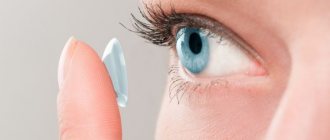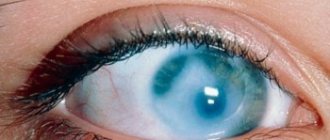Quite often, people who use contact lenses instead of glasses encounter the problem that the lens does not stick to the eye. This usually happens to beginners who have not yet learned how to use it correctly, and the author of these lines is no exception (at least, he was not one at first). So, today I will tell you about the possible causes of this problem and how to solve it.
- 6.1 Video: The lens does not come off your finger. Adviсe
Reason #1. The lens doesn't stick because it's turned inside out
This happens quite often; even the most experienced lens wearers sometimes try to put the product on the wrong side. Determining the correct position is very simple: place the product on your index finger and carefully examine it. If you see several numbers (“123”, in exactly that sequence), then everything is fine. But if they read “321,” then such a lens will not stick to the eye, because it is inverted.
If the numbers read correctly, the lens is not inside out
Another way to define "correct"
Can the lens roll inward behind the eyeball?
The structure of the eye provides protection against foreign bodies entering the space between the eyeball and the orbit.
The bones of the skull form a recess - the orbit, in which the eye is attached using soft tissue. The following are involved in eye fixation:
- muscles that move the eyeball;
- retrobulbar (from Latin - “located behind the eye”) fatty tissue;
- Tenon's capsule;
- lower and upper eyelid;
- conjunctiva;
- vessels and nerves.
The conjunctiva is a thin transparent film, one of the tasks of which is to protect the eye socket. The conjunctiva is attached to the inner surface of the upper and lower eyelids and the visible part of the sclera (the outer shell of the eye, normally white or light gray).
The contact lens must be on the cornea to be used. This is the convex, transparent part of the eye that covers the pupil (the black dot or circle in the center of the eye) and the iris (the colored ring around the pupil). When blinking, scratching the eye, or strong eye movements, the lens may shift. Often, after being displaced, it returns to its place on its own.
The conjunctiva makes it impossible for anything to enter the eye socket. There is no way the lens will roll back! But lens displacement is possible. Sometimes a person himself is not able to detect the lens after it moves along the conjunctiva.
In what cases is this possible?
Wearing lenses requires following a few simple rules:
- avoid intense rubbing of your eyes with your fingers;
- remove lenses before showering, bathing or swimming;
- All manipulations to remove or put on contact lenses should be carried out with clean hands.
Up or down movements of the eye create folds of the conjunctiva, in which a small foreign object can “hide”. Failure to follow the rules for wearing and removing contact lenses can lead to the lens moving into such a fold. This situation is sometimes similar to a lens falling out.
Reason #2. Incorrect selection or manufacturing defect
In this case, all you have to do is go to the optician where the purchase was made and protect your rights as a consumer.
Note! Before this, be sure to consult with an ophthalmologist to find out that the reason lies precisely in marriage or incorrect selection.
Sometimes the reason is a banal factory defect
We also note that when choosing, it is better to give preference to models with high humidity.
Find out detailed information on how to properly put on lenses for the first time from our new article on our portal.
Other violations of the terms of use
The operating rules must be followed. If you touch anything before putting it on, the lens will not stick due to greasy or dirty elements. Before use, wash your hands and dry thoroughly with a lint-free towel.
If the lenses are reusable, while wearing them you should not allow particles of any products, for example, cosmetics, to get in contact with them. Otherwise, they may not stick next time. The eyeball should be moisturized, so wash your face with water. If you have several unsuccessful attempts, take a break of 10 minutes. In this case, it is also recommended to wash your face.
Some users do not remove the reusable optical device correctly, so it may become damaged.
The lens container should be tightly closed.
Reason #3. Mishandling
Sometimes lenses do not stick to the eyes because they are simply handled inappropriately. For this reason, before purchasing, you should definitely visit an ophthalmologist and get advice regarding wearing them.
Note! Many pharmacies have an on-site optometrist who can help you with this.
By the way, one of my friends even took special courses on wearing contact lenses (imagine, such exist). In general, skills and dexterity will definitely come with time.
What is a contact lens suction cup and how to use it?
A lens suction cup is a special device for putting them on and taking them off. They are easy to use, safe for both eyes and lenses, and reliable. The suction cups do not squeeze the optical product, as a result of which it does not deform. When using them, there is no need to stretch the eyelid, and most importantly, they will eliminate sticking. To use the puller for putting on, you need to do the following:
- squeeze the lower part of the suction cup handle and place its end on the convex part of the lens, unclench the pneumatic bulb;
- bring the optical product;
- squeeze the air bulb again;
- make circular movements with your eyes.
When removing, you must follow this algorithm:
- apply moisturizing drops;
- squeeze the pneumatic bulb and bring the suction cup to the eyeball at an angle of 90 degrees;
- Unclench the pear.
In any case, skill will come with time. In addition, you can consult with an ophthalmologist or attend special courses on the rules of using contact vision correction devices.
Reason #4. Violation of operating rules
There are a number of rules - I didn’t come up with them - that should never be broken. Never. Under no circumstances.
- If you purchased soft products, then you should not treat them with a multi-purpose solution intended for hard models.
- After placing in the storage container, be sure to check that they are completely covered with the solution.
- Multi-purpose solution cannot be used twice!
Do not use multi-purpose solution twice!
Note! If the lens does not stick, but you are 100% sure that it is not a defect, then pour the solution into the container, put it there and immerse it. After that, turn it out and do the same procedure. It is advisable to repeat this two or three times so that the product is thoroughly saturated with liquid. This usually helps.
Another good tip: if the product has been left without solution for a long time, it is better to throw it away.
Symptoms
The first time people use contact lenses, they experience various discomforts. But lens misalignment is different from the standard feeling of dryness and “tiredness” in the eye. The following feelings indicate displacement of a contact lens:
- "eyewinker;
- itching;
- pain, burning;
- dryness;
- difficulty blinking;
- blurred vision.
Tearing and redness of the eye also indicate a problem.
If any discomfort occurs, you should check the position of the lens. If it is not on the cornea, remove it and put it on again.
What to do if the lens sticks to your finger
Sometimes it happens that the lens does not stick to the cornea because it is glued to the finger. This happens mainly with green “lens wearers” who are not yet sufficiently trained. This problem is quite easy to solve: drop a few drops of the solution inside the product so that your finger remains dry. Then, after placing it in place, make a few gentle movements with your finger so that it comes off, then blink a few times.
If the lens sticks to your finger, then most likely you simply do not have enough experience
If everything was done correctly, the lens will not stick to the finger, but will fit correctly on the iris. But if you have difficulties with this, maybe you will be interested in a suction-puller?
Video: Top 5 mistakes made by newbies in lenses
What to do?
Moisturizing drops will help pull the optical disc out of the visual organ.
To begin with, it is worth understanding that the lens remains outside the colored iris. The material from which it is made is thin and transparent, which makes it almost invisible. You can lose it unnoticed in the shower or while washing your face. And sometimes it becomes difficult to remove due to poor eye moisture. In this case, you need to use drops.
If the lens still disappears, you need to proceed as follows:
- Apply suitable drops to the eye. For example, artificial tears. This will provoke movement of the product and allow it to slide down from under the eyelid without additional intervention.
- If intervention is required, hands should be washed and the area lit. Take a mirror. Gently pull back the upper eyelid and find the lens there. If you don’t succeed the first time, you need to put drops in your eyes. It moves easier on a wet eye. Frequent blinking will also help with movement. When the product is on the edge of the eyelid or in the area, pull it out.
- If you cannot carry out the procedure yourself, you should contact an ophthalmologist as soon as possible. It will definitely help determine whether the product was able to get behind the eyeball. She can't stay there.
A corrective contact product that gets caught under the eyelid causes discomfort and the development of conjunctivitis.
To prevent this incident from happening again, you need to choose the right contact corrective product and follow doctors’ recommendations regarding use. You also need to remember that lenses have an expiration date and after it expires you should not wear them, as it is unsafe and they could become deformed.
Putting it on correctly
To avoid this kind of problem, everything should be done according to the instructions. Here she is.
Step 1. First, wash your hands thoroughly and dry them with a lint-free towel.
Step 2. The product is placed on the tip of the index finger, and it is checked whether it is in the correct position (using the indicators that I have already described). The surface must be moist and clean, otherwise you will feel discomfort and a feeling of a foreign object in the eye when wearing it.
Step 3. Hold the upper eyelid with two fingers so as not to blink. Then, with the other hand (any finger except the index finger), the lower eyelid is pulled back, although this can also be done with the thumb of the first.
Let's learn to put it on correctly!
Step 4. The product is placed with the index finger slightly below the pupil.
Step 5. The lower eyelid lowers, the eye rises several times to the ceiling.
Look up several times
Step 6. The top one is lowered.
Step 7. At the end, you need to blink several times. You should never rub your eyes!
Video: The lens does not come off your finger. Adviсe
No need to rub your eyes after the procedure
Find out detailed information on how to determine the correct side of a contact lens, and what will happen if you put it on the wrong side, from our new article.
Video: How to put on lenses correctly
If you strictly follow the instructions, your contact lenses will always adhere to your eyes correctly. And in conclusion, some more practical advice from a specialist.
- The eyes should not be dry; it is necessary to wash with water (preferably cold) to moisten the eyeball.
- If a few drops of solution have been dropped inside the product, then you should not press hard into the eye - you just need to touch it lightly for the lens to snap into place.
- After several unsuccessful attempts, you need to wash your face and take a ten-minute break.
- Sometimes people are allergic to a certain type of eye lens, which leads to irritation. Quite strange, but it's true.
Actually, that's all. Take care of your eyes!
To quickly remove swelling from the eyes in the morning, you can study the details in our other article.
How to wear lenses
There are general rules for putting lenses on your eyes. If you follow them step by step, you will be comfortable wearing them, and they will stick to your eyes much better.
One hand
- Remove the lens from the box by grabbing it with your fingertips.
- With the same hand (only the middle finger) we lower the eyelid slightly down.
- Look up at the ceiling and calmly drag the lens to the white part of your eye.
- Slowly and carefully lower the eye, and also carefully release the eyelid.
- Close your eyes for about 3-4 seconds.
With two hands
- Take the lens. Now place it above the knuckle of your thumb.
- Lift the eyelid using the index finger and thumb of your other hand. Place the lens against your eye.
- Close your eyes for 3-4 seconds.
- If after opening your eyes you feel comfortable, then you did everything right.
Also make it a habit to put your lenses on either your right or left eye first. This way you will get used to this particular order, the process will be simpler and will take less time.
Expert advice
Experts strongly recommend following all rules for using lenses. To put on your lenses, wash your hands before putting them on. Do not dry them with a lint towel. Place the lens on the end of your finger and check that it is positioned correctly relative to the eye.
Each lens has an indicator that will help you determine if it is positioned correctly. The lens should be slightly damp, otherwise the eye will appear to have a foreign object. Do not scratch your eyes with your hands, as you may cause an infection and stain the lens.
Try to keep your eyes hydrated, so use cool water or drops to moisturize them. By following these rules, you will be able to quickly put on lenses over time and they will stick to your eyes normally.
The following picture shows how to properly wear contact lenses. Follow these rules:
Sometimes the lens does not stick due to an allergy to the components contained in the lens. In this case, consult a doctor. He will select new lenses for you. Also, experts do not recommend keeping the lens for a long time without solution. If this happens, then the best solution would be to throw it away, because it is already dry and dirty, and therefore not suitable for use.
This thing is extremely capricious, so approach it responsibly. Doctors recommend that every time you take your contact lenses out of the case, you thoroughly rinse and dry it. It can easily become a breeding ground for dangerous bacteria.
If suddenly your lenses begin to stick to your eyes much worse and you begin to experience discomfort while wearing them, then you need to consult a doctor; do not put this problem off for a long time.
Also, do not use solutions that were prepared at home. Other home remedies will not work either. Use only saline solutions specifically designed for this purpose.
Keep the solution clean, because it is as easy to deteriorate as the contact lens itself. The opinion of experts is very important, it is definitely worth listening to. All of these factors can reduce the likelihood of the lens not sticking to the eye. At the same time, you will also take care of the health of your eyes.
Acuvue against astigmatism
These are some of the most comfortable lenses available on the domestic market. According to statistics, about 80 percent of people who tried to wear these lenses no longer change them to other models. Many lens users know that silicone hydrogel lenses are more rigid than regular hydrogel lenses, and this is why many users have trouble getting used to them.
The technology used to make lenses does not dry out the eyes. The moisturizing hydrogel seems to be sewn into the very structure of the silicone of the lens, and will not be washed out of it during use.










